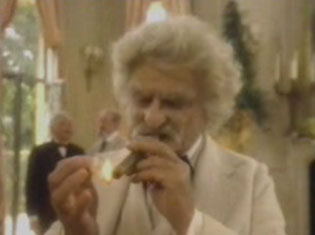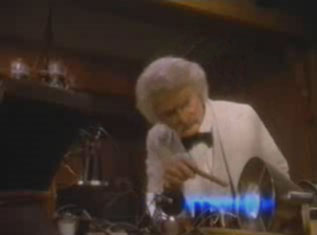Mark Twain in the 24th Century
Things to Note
In "Time's Arrow," Parts I and II, Samuel Clemens, aka Mark Twain, bumps into the crew of the USS Enterprise in late-nineteenth century San Francisco. While the episode doesn't have much to do with any of Twain's novels, it is very instructive in seeing the kind of viewpoints and images associated with Mark Twain today.
Twain's Image
The first and most important aspects of Twain's presentation in Star Trek is his image and where the writers chose to place Twain. Twain is depicted, as he invariably is today, as a crotchety old cigar-smoker in a white suit. His place of residence in 1893 is San Francisco, according to the episodes. But these are both anachronistic. Twain didn't start wearing the white suit until December, 1906, but he is invariably wearing the suit when depicted today.
 Second,
Twain lived in Hartford, CT and abroad for most of his later years, leaving
San Francisco and the West behind him at a relatively young age. Twain
would not have been living in or visiting San Francisco during this time
period. As Valerie Fulton points out in her
essay, "An Other Frontier:
Voyaging West With Mark Twain and Star Trek's Imperial Subject": "Despite
the fact that Clemens left San Franscisco in 1866, at the age of thirty-one,
the show depicts him in the guise of the white-haired, white-suited
curmudgeon whom Americans readily recognize--in large part because a
white-haired, white-suited automaton 'Mark Twain' greets millions of
visitors each year to Disney's Frontierland."
Second,
Twain lived in Hartford, CT and abroad for most of his later years, leaving
San Francisco and the West behind him at a relatively young age. Twain
would not have been living in or visiting San Francisco during this time
period. As Valerie Fulton points out in her
essay, "An Other Frontier:
Voyaging West With Mark Twain and Star Trek's Imperial Subject": "Despite
the fact that Clemens left San Franscisco in 1866, at the age of thirty-one,
the show depicts him in the guise of the white-haired, white-suited
curmudgeon whom Americans readily recognize--in large part because a
white-haired, white-suited automaton 'Mark Twain' greets millions of
visitors each year to Disney's Frontierland."
However, Twain does have the unique position of occupying several home spheres. If you look at a sampling of Clemens obituaries from around the country, papers from the West and East both claim him as their own--the only papers that as a rule do not are the Southern papers--somewhat ironically, for he was born in Hannibal, MO. It seems that the Star Trek portrays him not accurately but entirely in keeping with Modern America's conception of Twain. The Star Trek creators did get his cigar smoking right, though--Twain was certainly fond of cigars.
-
to learn more about the white suit, click here
-
to view Mark Twain discussing cigars on Star Trek, click here
Halley's Comet
Clemens died on the 22nd of April, 1910. Halley's comet was visible to the naked eye that night, for the first time in about 75 years. In a truly remarkable coincidence, it was also visible to the naked eye on November 30, 1835--the date of Clemens birth. Clemens had this to say of Halley's comet: "I came in 1835 with Halley's Comet . . . and I expect to go out with it. It'll be the great disappointment of my life if I don't. The Almighty has said, no doubt, 'Now here are two indefinable freaks. They came in together. They must go out together.' Oh, I am looking forward to that."
The Star Trek writers pay homage to this coincidence, when, late in the episode, they have Twain facetiously ask about the comet: "So, this is a space-ship...did you ever run into Halley's comet? Ha-hah!"
-
to view the Star Trek video clip of Twain asking about Halley's comet, click here
Gadgets
The creators of Time's Arrow Part 1 and 2 portray a Mark Twain who is entirely suspicious of new gadgets and inventions. He talks about how his Connecticut Yankee ruined the past with his new-fangled inventions; he is entirely suspicious of the machine Data created (and even steals a piece from it), and discusses several times that he fears the inventions of the future.
 However, there is good evidence that Twain was
actually very
fascinated with gadgets, and even went bankrupt because of too-great
a speculative interest in a new type of printing press. Fulton
references John Lauber, "[who] notes in the preface to his biography of the
writer, he was even "an inventor in a small way, patenting a self-pasting
scrapbook and a self-adjusting vest strap, copyrighting a game to teach
historical facts, even imagining microprint."
However, there is good evidence that Twain was
actually very
fascinated with gadgets, and even went bankrupt because of too-great
a speculative interest in a new type of printing press. Fulton
references John Lauber, "[who] notes in the preface to his biography of the
writer, he was even "an inventor in a small way, patenting a self-pasting
scrapbook and a self-adjusting vest strap, copyrighting a game to teach
historical facts, even imagining microprint."
Imperialism
By the end of Samuel Clemens' life, he wrote several pieces that were harshly critical of imperialism, most notably, "To a Stranger Sitting in Darkness" and "The War Prayer," as well as a number of editorials and anti-imperialism essays. He held very anti-imperialist views against Spain during the Spanish-American war, and subsequently attacked America for not liberating the Philippines once the territory was given to the US following the Treaty of Paris, during Spanish-American peace accords. He championed deposed Philippine leader Emilio Aquinaldo as akin to great men like George Washington, fighting as rebels against colonial occupation.
In these episodes of Star Trek, the writers have interpreted Twain's views as such. Twain first appears as extremely suspicious and is a constant meddler. He overhears Data and Guinan's conversation about how Data has arrived from the future. Fearing new-fangled gadgetry and imperial colonization, Twain begins to try his best to sabotage Data's plans, including stealing a piece from a bit of machinery Data invented, threatening Star Trek crew members with a gun, and even slipping onto the USS Enterprise instead of Captain Picard. He speaks of how he had written a book, A Connecticut Yankee in King Arthur's Court, that was about a time traveler who messed up the past with his inventions and meddling. As Fulton points out,
This frankly anti-imperialist gloss of A Connecticut Yankee in King Arthur's Court typifies Clemens's initial response to the Federation, whose motives he compares to those of the Spanish, Dutch, and Portugese. Skeptical about whether the U.S.S. Enterprise can really be a "ship of peace," the writer objects that this is "what all conquerors say."
But an anti-imperialist gloss of Yankee is hardly the only interpretation. Again, Fulton references Werner Sollors, who "points out [that] the novel is not easily reduced to a clear or stable interpretation; it has been "embattled by interpreters" who question whether it constitutes "light and humorous praise of worthy progress" or is instead "a bitter and gloomy anticipation of the century of nuclear holocausts and mass genocides."
The Star Trek crew members eventually convince Twain that the future is actually a very positive place, and that they are not evil imperialists. Twain, surprisingly, seems quite convinced by the end of the second episode--he thanks Data as he leaves, thanking him for "helping a bitter old man" find out that the future "turned out pretty well, after all."
The question becomes: do these episodes of Star Trek oversimplify and create a happy ending? To a certain extent they have to, do to constraints of portraying a complex character in a TV episode format. View the clips below and decide for yourself:
-
to view Star Trek's Mark Twain discussing A Connecticut Yankee in King Arthur's Court, click here
-
to view Star Trek's Mark Twain discussing anti-imperialist worries, click here
-
to view a changed Mark Twain, click here
-
to view Star Trek's happy ending, click here
Sam Clemens/Mark Twain
Any good student of Mark Twain knows the kind of dual-life he led as both Samuel Clemens and Mark Twain, and that Mark Twain is very much a public persona, created by Samuel Clemens for purposes of his own. So it is somewhat surprising when, at the end of the Episode, Clemens tells Picard that in order to know him better, he ought to read his books--for "What I am is pretty much there." Certainly there are ways that Clemens the person and Twain the character differ. Is this too-great of a simplification?